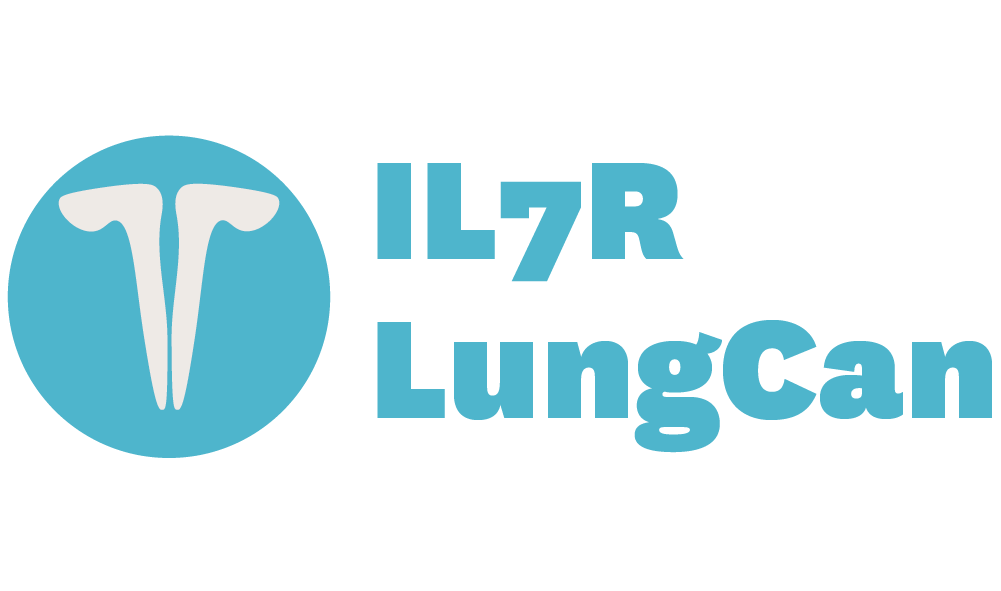Preliminary data
IL-7 is produced by stromal cells and its availability largely controlled by consumption by IL-7R+ cells, which compete for this limited resource based on their IL-7R levels in a process normally restricted to lymphoid cells. However, our preliminary data, using protein Digital Spatial Profiling (DSP) in NSCLC patient samples, indicate that IL-7R expression in cancer cells frequently exceeds that in the immune infiltrate. IL-7 levels are reduced in tumor site bronchoalveolar lavage fluid from NSCLC patients, especially with more advanced disease, suggesting NSCLC cells consume IL-7.
Consequently, our underlying hypotheses are two-fold:
1) IL-7 drives cancer outgrowth and/or metastasis by promoting the viability, proliferation or invasion ability of NSCLC cells;
2) NSCLC cells outcompete T cells in their ability to consume and benefit from IL-7, compromising anti-tumor activity and promoting resistance to PD-1 axis inhibition.
Our preliminary studies indicate that IL-7 promotes proliferation and invasion of human IL-7R+ A549 NSCLC cells. Also, making use of immunodeficient mice with or without IL-7 deficiency we found that IL-7 promotes A549 tumor growth in vivo. We will extend these analyses to patient-derived xenograft (PDX) samples, making use of our already established PDX models of solid tumors. In addition, we have generated a conditional knock-in model in which the human IL7R is under the control of the ubiquitous Rosa26 promoter and is expressed only upon Cre recombinase activity.
Crossing with CD2-Cre mice (to induce IL7R overexpression in lymphoid cells) allowed us to show that high IL7R levels are sufficient to drive T-cell leukemogenesis. Using adenoviral-mediated delivery of Cre into the lungs of IL7R and/or KRAS mutant conditional mice, we will characterize the impact of IL7R overexpression in the context of KRAS–induced lung tumorigenesis in an immunocompetent scenario.
In a pilot discovery study, we used DSP to identify spatially-resolved protein markers associated with benefit from single-agent PD-1 axis blockade in advanced NSCLC. We quantified the expression of 44 protein markers in single tissue sections from 4 molecularly-defined compartments. We observed that some NSCLC cases expressed remarkably high levels of IL-7R in the tumor cell compartment. High IL-7R expression in the tumor cell compartment associated with non-clinical benefit and shorterprogression-free survival (PFS) under single-agent PD-1 axis inhibition, independently from other prognostic factors. Remarkably, this negative association was not observed when IL-7R 5expression was measured in the immune compartment, suggesting that IL-7R upregulation specifically in tumor cells might be a novel tumor-intrinsic resistance mechanism to PD-1 axis blockade in NSCLC. In order to validate this finding in independent patient cohorts, we are currently assessing tumor samples from patients treated with single-agent PD-1 axis blockade at the 12 de Octubre University Hospital, Madrid. Using DSP, we are measuring the expression of 44 immuno-oncology proteins (including IL-7R) from immune-enriched regions of interest (ROI) in spatial context.
Finally, a key aspect of our proposal involves the design of next-generation proteolytically-activated bispecific monoclonal antibodies (mAbs) by tumor-associated proteases, to target IL-7R selectively in cancer cells and concomitantly either promote T cell recruitment (via anti-CD3) or block PD-L1, which is co-expressed with IL-7R in tumor cells. Establishing these new therapeutic tools, which we will test in humanized immunoavatar mice we have successfully established, will rely on our experience in molecular and cell engineering and benefit from our previous creation of an anti-IL-7R mAb for leukemia treatment.


